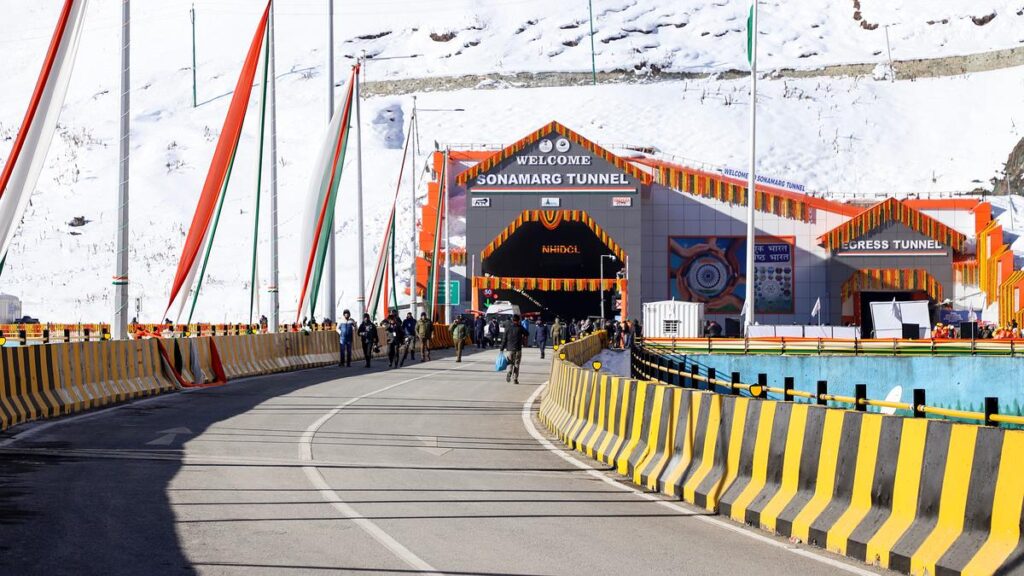
A view of the decorated ‘Z-Morh’ Sonmarg tunnel that connects Gagangir and Sonamarg on the Srinagar-Leh highway, in Ganderbal on Monday.
| Photo Credit: ANI
The government’s ambitious proposals to construct highways and develop satellite townships in Jammu and Kashmir (J&K) have led to fear among the locals, who feel that these projects could disrupt the region’s delicate ecological balance, displace communities, and alter the demographic and cultural fabric.
In 2021, the government approved a semi-ring road project and acquired 900 acres of cultivated agricultural land for it. The district that is most affected by this project is Budgam, followed by Pulwama, Srinagar, Ganderbal, Bandipora, and Baramulla. This mega project, aimed at reducing traffic in the Kashmir Valley, will be implemented in two phases. Farmers worry about their livelihoods as thousands of apple, plum, and pear trees have already been axed to clear the land for the construction of the new highway, which the locals fear will be used for security and tourism purposes alone. The project will feature numerous infrastructure elements, including 290 culverts, two road over bridges, two flyovers, 10 major junctions, 26 minor junctions, and a toll plaza at the Narbal junction.
J&K is predominantly an agrarian economy. More than 80% of the population is directly or indirectly associated with agriculture. This mass acquisition of land has exerted tremendous pressure on the land resources of J&K, which has some of the smallest land holdings in the country. The landowners were not compensated adequately for the loss of their land. This is because they received compensation not under the Right to Fair Compensation and Transparency in Land Acquisition, Rehabilitation, and Resettlement Act, 2013, but under the Jammu and Kashmir Land Acquisition Act, 1934, which was removed from the statute books after the dilution of Article 370. In J&K’s rural economy, commercial apple farming and its value chain is the mainstay of the economy. This generates an estimated revenue of around ₹1,500 crore. Transforming such fertile lands into construction sites will be disastrous for the region’s economy and ruin the livelihoods of lakhs of people.
In May 2022, a notification under the J&K Town Planning Act, 1963, imposed a moratorium on land transactions within 500 meters of the ring road. However, in October 2024, the Housing Board announced in a notification plans for establishing 30 satellite townships along the semi-ring road. Each township will cover an average area of 200 hectares, requiring a total of 6,000 hectares, most of which is agricultural land. These settlements risk displacing people and leaving marginal farmers landless as a significant portion of land has already been acquired and more land is expected to be acquired soon.
Ever since J&K became a Union Territory in 2019, there has been a thrust on development. The government has either proposed new projects or given a fillip to already commissioned projects, which have been languishing due to paucity of funds. The unrestrained march of infrastructure development in the region is leading to ecological ruin and social displacement. While the government has promised enhanced connectivity and economic progress, these projects strike at the heart of the region’s fragile ecosystems and hurt its agrarian backbone. The destruction of agricultural lands and orchards will strip the region of its biodiversity, displace wildlife, and erode its green cover. Construction activities will accelerate soil erosion, rendering land infertile and crippling agricultural output.
J&K has 14.3 lakh farming households and an average landholding of just 0.25 hectares. It contributes 80% of India’s temperate fruit production. Yet, massive land acquisitions for infrastructure projects, often carried out without robust social impact assessments, are dismantling these livelihoods.
Calamities such as the 2014 floods have laid bare the ecological fragility of the region. The blind pursuit of urbanisation and the relentless push for building highways, railways, and satellite townships heightens the risk of more such disasters. This is not progress — it is a slow, methodical unravelling of J&K’s ecological integrity and the livelihoods that depend on it. Without urgent course correction, the price of this so-called progress will be borne by generations to come.
Bilal Wagay teaches Politics at Government Degree College Beerwah, Jammu and Kashmir; and Ummar Jamal is a student activist and national president of the J&K Students Association
Published – February 04, 2025 12:22 am IST
Source:https://www.thehindu.com/opinion/op-ed/the-precarious-road-to-development-in-jammu-and-kashmir/article69175688.ece

